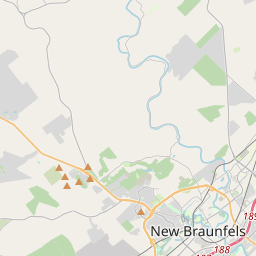New Braunfels: County Seat of Comal County
Historical marker location:






Early inhabitants of this area included Karankawa, Lipan, Tonkawa and Waco Indians. Between 1844 and 1846, the Verein Zum Schutze Deutscher Einwanderer in Texas (Society for the Protection of German Immigrants in Texas) sent more than 7,000 German settlers. Several hundred of them arrived in this area in 1845. Led by Prince Carl of Solms-Braunfels, they founded a community here on Good Friday, March 21, of that year. Rafael L. and Maria Antonia Veramendi Garza sold the colonization society more than 1,200 acres of land for the settlers, who held a drawing for lots shortly after arriving. Briefly referred to as Comal Springs, the community was named New Braunfels for the German town of Braunfels on the Lahn River. On May 11, 1846, the Texas Legislature incorporated the city, although the charter was not ratified until the following year. By 1850, New Braunfels was reportedly the fourth largest city in Texas. Because of its temperate climate and abundant natural resources, agriculture and industry thrived. Early craftsmen included bakers, blacksmiths, butchers, button and fringe makers, cabinetmakers, carpenters, coppersmiths, locksmiths, machinists, saddlers, tailors, shoemakers, tanners, tinsmiths, turners and wagon makers. Industries included brick kilns, cotton gins, a door and blind factory, flour and grist mills, breweries, a sawmill, a soap and candle house, and a woolen mill. The city's settlers were undaunted by early hardships. Many old-world customs survive among descendants of the original colonists, and the city's heritage is reflected in its buildings, street names and institutions. (1970, 2005)
As one of the most visible programs of the Texas Historical Commission (THC), historical markers commemorate diverse topics in Texas history, including: the history and architecture of houses, commercial and public buildings, religious congregations, and military sites; events that changed the course of local and state history; and individuals who have made lasting contributions to the state, community organizations, and businesses.
Texas is known for its love of football, and the state has produced many great football players, including legends like Tom Landry, Earl Campbell, and Vince Young.
In the early 19th century, German immigrants began to arrive, attracted by the fertile land and opportunities for a better life. These settlers established small farming communities and brought with them their language, traditions, and expertise in agriculture and craftsmanship. The town of New Braunfels was founded in 1845 by Prince Carl of Solms-Braunfels, becoming the first German colony in Texas.
The mid-19th century saw significant growth and development in Comal County, with the construction of schools, churches, and businesses. The area became known for its thriving agricultural industry, with farmers cultivating crops such as cotton and corn. The arrival of the railroad in the late 19th century further spurred economic growth and provided easier access to markets.
Throughout the 20th century, Comal County continued to evolve and adapt to changing times. The county's strong German heritage remained at the forefront, celebrated through events like Wurstfest, a German sausage festival. The tourism industry also grew, with visitors flocking to the county's natural attractions, such as the iconic Guadalupe River and historic Gruene Hall, Texas' oldest continually operating dance hall.
Today, Comal County is a vibrant and thriving community, blending its rich history with modern amenities and a strong sense of pride in its cultural heritage. With its beautiful landscapes, strong economy, and warm Southern hospitality, Comal County continues to be a desirable place to live and visit.
Comal County Timeline
This timeline provides a glimpse into the major events and milestones that have shaped the history of Comal County, Texas.
- 1846 - Comal County established as one of the original 23 counties in the state of Texas
- 1847 - Settlement begins in the area with the founding of New Braunfels
- 1850 - Comal County's population reaches 2,013
- 1861-1865 - County residents actively involved in the American Civil War
- 1870 - Completion of the first railroad through Comal County
- 1885 - Jacob's Well, a natural artesian spring, becomes a popular tourist attraction
- 1920s - Economic growth in Comal County, driven by agriculture and manufacturing industries
- 1941-1945 - County residents contribute to the war effort during World War II
- 1968 - Canyon Lake, a reservoir on the Guadalupe River, is completed
- 1990s - Rapid population growth and urban development in Comal County
- 2007 - Construction begins on the controversial Trans-Texas Corridor project